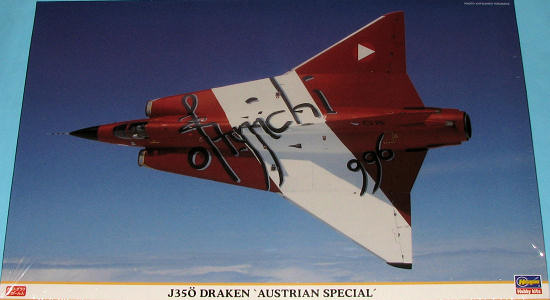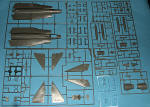
Hasegawa 1/48 Saab Draken "Austrian Special"
| KIT #: | 09817 |
| PRICE: | $ |
| DECALS: | Two options |
| REVIEWER: | Scott Van Aken |
| NOTES: | Limited reissue |

| HISTORY |
As the jet era started, Sweden foresaw the need for a jet fighter that could intercept bombers at high altitude and also take on fighters. Although other interceptors such as the US Air Force's F-104 Starfighter were being conceived during the same period, Saab's "Draken" would have to undertake a combat role unique to Sweden. Other demanding requirements were the capability to operate from public roads, used as temporary airfields and for refueling/rearming to be carried out in no more than ten minutes, even by conscripts with minimal training. In September 1949, the Swedish Defence Materiel Administration issued a request for a fighter/interceptor aircraft, and work began at Saab the same year.
Draken's design incorporated a distinctive "double-delta" configuration, with one delta wing within another larger delta. The inner wing has an 80° angle for high speed performance, while the outer 60° wing gives good performance at low speeds. Propulsion was provided by a single Svenska Flygmotor RM 6B/C turbojet (Rolls-Royce Avon 200/300). A ram turbine, under the nose, provided emergency power and the engine had a built-in emergency starter unit. The Draken could deploy a drag chute to reduce its landing distance.
The double-delta shape was so revolutionary that it warranted the only sub-scale test aircraft built in Sweden: the Saab 210, unofficially nicknamed "Lilldraken" (the little kite). The Saab 210 tested the concept of the double delta, first flying on 21 January 1952. The 210's successful testing results led to an order for three full-size Draken prototypes. The first prototype, not fitted with an afterburner, made its maiden flight on 25 October 1955. The second prototype, equipped with an afterburner, on its first flight, unintentionally broke the sound barrier while climbing.
Although not designed to be a dogfighter, the J 35 Draken proved to have good instantaneous turn capability and was a very capable fighter. It entered service in 1960 with the Swedish Air Force; 644 Saab Drakens were built for Sweden as well as other European nations. Sweden's Draken fleet came in six different variants while two Draken models were offered for export. The early models were intended purely for air-defense. The last model built was the J 35F, the final variant to remain in Swedish service. These aircraft have now been retired and replaced by the Saab Gripen.
The J 35 Draken design underwent several upgrades. The last was the J 35J version, in the late 1980s, although by then, the Draken had been almost totally replaced by the Saab Viggen in Swedish service. The J 35J was a service-life extension program since the delivery of the new Saab JAS 39 Gripen was still in the development stage and suffering from delivery delays. The extension program was to keep the Draken flying into the 2000s, but due to cutbacks and high maintenance costs the Draken was eventually phased out. The Swedish Drakens were officially retired in December 1998, although the type remains in limited numbers in both military and civilian versions. Export customers included Denmark and Finland. In 1985, the Austrian Air Force purchased 24 J 35D s totally reconditioned by Saab, designnated J 35Ö.
All Drakens are interceptors with limited air-to-ground capability, with the sole exception of the Danish Drakens, which are strike aircraft capable of carrying AGM-12 Bullpup missiles, advanced "jammers", and increased internal and external fuel stores. The Danish Drakens are so far the heaviest of the series to have been in service. Danish F-35 aircraft were retired in 1993.
Finland updated its 35X fleet with new avionics, cockpit displays, navigational/attack systems and electronic countermeasures during the 1990s but finally retired the Draken in 2000.
Austria was the last country to operate the Draken in military service. They bought refurbished J 35D which was the last variant with two internal cannon due to the Austrian restriction of not being allowed to carry air-to-air missiles. These Drakens were retired in 2005, when they were replaced by former Swiss Tiger IIs, while waiting for new Eurofighters.
In the United States, the National Test Pilot School (NTPS) owns six Drakens that were formerly in Danish service; of these, two TF-35XD s and one RF-35XD are operational, based at the Mojave Spaceport.
| THE KIT |
 As one would expect from Hasegawa, this particular boxing falls pretty much in line with their 1/72 kits and offers an Austrian variant of this aircraft. About 95% of the plastic is the same in both kits, however, there are some small differences in this boxing. One is the deletion of the undernose IR seeker as Austrian aircraft are forbidden by treaty to carry air to air missiles. This was part of the deal that moved Austria out of the Soviet sphere of influence after WWII. However, the aircraft can carry guns and air to ground weapons so pylons for Maverick missiles are included. Of course, you'll have to get the missiles from the Hasegawa weapons set as none are included. Also different is the instrument panel and its detailing. New fin tips with ECM fairings are included and I believe that the additional bits for under the exhaust are ECM antennas as well.
As one would expect from Hasegawa, this particular boxing falls pretty much in line with their 1/72 kits and offers an Austrian variant of this aircraft. About 95% of the plastic is the same in both kits, however, there are some small differences in this boxing. One is the deletion of the undernose IR seeker as Austrian aircraft are forbidden by treaty to carry air to air missiles. This was part of the deal that moved Austria out of the Soviet sphere of influence after WWII. However, the aircraft can carry guns and air to ground weapons so pylons for Maverick missiles are included. Of course, you'll have to get the missiles from the Hasegawa weapons set as none are included. Also different is the instrument panel and its detailing. New fin tips with ECM fairings are included and I believe that the additional bits for under the exhaust are ECM antennas as well.
 Instructions are typical for Hasegawa with Gunze paint references, well drawn illustrations and notes about opening holes and such. Markings are given for two aircraft. One is the special paint scheme plane as shown on the box art in red and white celebrating the 1,000th year of the nation of Austria. The other is a standard greys scheme with one set of large upper wing markings. There are additional code numbers, but to use any other than 24, you'll be modeling an initial delivery aircraft before the large code numbers were added to the upper wing. Decals are superbly printed in bright colors and should react well to any setting solutions.
Instructions are typical for Hasegawa with Gunze paint references, well drawn illustrations and notes about opening holes and such. Markings are given for two aircraft. One is the special paint scheme plane as shown on the box art in red and white celebrating the 1,000th year of the nation of Austria. The other is a standard greys scheme with one set of large upper wing markings. There are additional code numbers, but to use any other than 24, you'll be modeling an initial delivery aircraft before the large code numbers were added to the upper wing. Decals are superbly printed in bright colors and should react well to any setting solutions.
| CONCLUSIONS |
This is really one superb kit and now we have another interesting boxing. If you missed the base kit or just want the Austrian AF version, this is the one for you.
| REFERENCES |
October 2008
Thanks to www.dragonmodelsusa.com for the preview kit. Get yours today at your local hobby shop or on-line store.
If you would like your product reviewed fairly and fairly quickly, please contact the editor or see other details in the